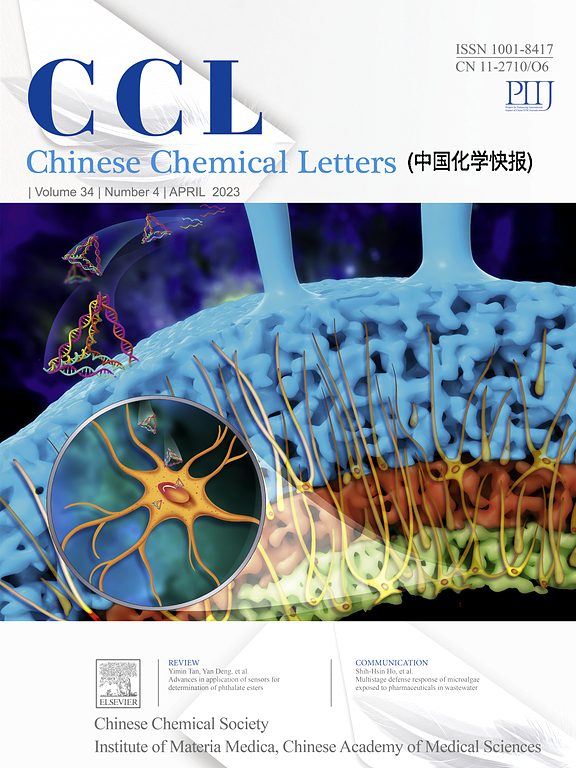钙钛矿太阳能电池用二苯并杂环核基空穴传输材料的分子工程研究
IF 9.4
1区 化学
Q1 CHEMISTRY, MULTIDISCIPLINARY
引用次数: 0
摘要
杂环化合物在钙钛矿太阳能电池(PSCs)的有机空穴传输材料(HTMs)中起着重要的作用。本文设计并合成了一系列具有不同二苯并杂环核心(二苯并呋喃、二苯并噻吩、二苯并噻吩砜)的线性D-π-D HTMs (OCBz、S-CBz、SO2-CBz),并研究了它们在psc中的应用。本征性质(CV、UV-vis、空穴迁移率和电导率)的系统研究表明,这三种材料都是平面n-i-p型psc的合适材料。由于S-CBz具有优异的空穴迁移率和电导率、良好的成膜能力以及出色的电荷提取和传输能力,以S-CBz为HTM的fapbi3基PSCs的PCE为25.0 %,优于相同条件下制备的spio - ometad基PSCs(23.9 %)。此外,由于S和Pb2+之间的相互作用,基于S- cbz的PSC器件表现出更好的稳定性。这项工作表明,基于二苯并噻吩的结构是钙钛矿太阳能电池结构中高性能HTMs的有希望的候选者。本文章由计算机程序翻译,如有差异,请以英文原文为准。

Molecular engineering of dibenzo-heterocyclic core based hole-transporting materials for perovskite solar cells
Heterocyclic compounds play an important role in organic hole transport materials (HTMs) for perovskite solar cells (PSCs). Herein, a series of linear D-π-D HTMs (O![]() CBz, S-CBz, SO2-CBz) with different dibenzo-heterocycles core (dibenzofuran, dibenzothiophene, dibenzothiophene sulfone) were designed and synthesized, and their applications in PSCs were investigated. The intrinsic properties (CV, UV–vis, hole mobility and conductivity) were systematically investigated, demonstrating that all three materials are suitable HTMs for planar n-i-p type PSCs. Benefiting from the excellent hole mobility and conductivity, good film forming ability, and outstanding charge extraction and transport capability of S-CBz, FAPbI3-based PSCs using S-CBz as HTM achieved a PCE of 25.0 %, which is superior to that of Spiro-OMeTAD-based PSCs fabricated under the same conditions (23.9 %). Furthermore, due to the interaction between S and Pb2+, S-CBz-based PSC devices exhibited improved stability. This work demonstrates that dibenzothiophene-based architectures are promising candidates for high-performance HTMs in perovskite solar cell architectures.
CBz, S-CBz, SO2-CBz) with different dibenzo-heterocycles core (dibenzofuran, dibenzothiophene, dibenzothiophene sulfone) were designed and synthesized, and their applications in PSCs were investigated. The intrinsic properties (CV, UV–vis, hole mobility and conductivity) were systematically investigated, demonstrating that all three materials are suitable HTMs for planar n-i-p type PSCs. Benefiting from the excellent hole mobility and conductivity, good film forming ability, and outstanding charge extraction and transport capability of S-CBz, FAPbI3-based PSCs using S-CBz as HTM achieved a PCE of 25.0 %, which is superior to that of Spiro-OMeTAD-based PSCs fabricated under the same conditions (23.9 %). Furthermore, due to the interaction between S and Pb2+, S-CBz-based PSC devices exhibited improved stability. This work demonstrates that dibenzothiophene-based architectures are promising candidates for high-performance HTMs in perovskite solar cell architectures.
求助全文
通过发布文献求助,成功后即可免费获取论文全文。
去求助
来源期刊

Chinese Chemical Letters
化学-化学综合
CiteScore
14.10
自引率
15.40%
发文量
8969
审稿时长
1.6 months
期刊介绍:
Chinese Chemical Letters (CCL) (ISSN 1001-8417) was founded in July 1990. The journal publishes preliminary accounts in the whole field of chemistry, including inorganic chemistry, organic chemistry, analytical chemistry, physical chemistry, polymer chemistry, applied chemistry, etc.Chinese Chemical Letters does not accept articles previously published or scheduled to be published. To verify originality, your article may be checked by the originality detection service CrossCheck.
 求助内容:
求助内容: 应助结果提醒方式:
应助结果提醒方式:


